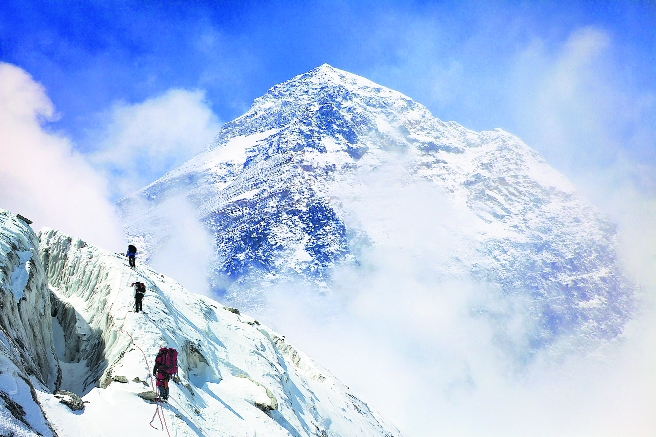The World Beneath Their Feet by Scott Ellsworth. John Murray/Hachette. Pages 394. Rs699
Book Title: The World Beneath Their Feet
Author: Scott Ellsworth
Avay Shukla
“This is a book about the mountains. But it is also a book about the men and women who dared to match them.” These opening lines by the author provide the essence of this detailed narrative on conquering the Himalayas in the first half of the last century, particularly the ‘Achttausenders’, the 10 peaks above 8,000 metres. The lofty crown of the Himalayas remained the only unexplored territory on the planet where the human imprint was still missing.

This fascinating book is set against a twin backdrop: one, the evolution (skills, technology, knowledge) of mountaineering which was as yet a developing adventure activity; and two, the geo-political context of the time — the waning power of England, the rise of the Nazis in Germany, the aftermath of the Great War. In a proxy competition, the ‘Achttausenders’ became the focal point of rivalry between England, USA and Germany for global stature and influence. Conquering the Himalayas turned into a goal that would validate their respective ideologies and their greatness, in the eyes of their own people and the world.
The author’s focus, however, never shifts for long from the incredible men and women — the mountaineers and the Sherpas — whose heroic feats of resolve, perseverance, strength, courage and sacrifice are recorded in mesmerising detail. Like the three doomed Sherpas in the 1939 attempt on K2 who climbed an incredible 6,600 feet in one day from Base Camp to Camp Seven to rescue a stranded American climber. All four were never heard of again, just some of the hundreds these mighty peaks have taken as sacrifice for man’s presumption in challenging these eternal sentinels.
By the 1930s, the highest peaks of the Karakoram and Hindukush ranges had more or less been parcelled out among the three great powers: Everest “belonged” to the British, Nanga Parbat to the Germans and K2 to the Americans. None had been summitted in spite of numerous attempts; only Nanda Devi had been conquered, by an Anglo-American team in 1936, but it was not an ‘Achttausender’.
This book records, in captivating detail, the various attempts made to conquer these forbidding peaks: four on Everest by the British after George Mallory and Sandy Irvine’s ill-fated expedition of 1924, three by the Americans on K2, three on Nanga Parbat by the Germans who perhaps suffered the maximum casualties. But these intrepid mountaineers kept coming back again and again, in a love affair where rejection was just not acceptable. Their indomitable resolve is ultimately what this book is about.
The first ‘Achttausender’ to be climbed successfully was Annapoorna, the 10th highest peak in the world. This was achieved by a French team, led by Maurice Herzogg, on June 3, 1950. For the British, who had so far failed in 10 attempts on the Everest, this was a spur to redouble their efforts.
By this time, however, China had occupied Tibet and barred all foreigners from it; the usual northern route was no longer available and the peak could be approached only from its south face in Nepal. Fortunately for them, this route had been attempted by Shipton and Smythe in 1938 and the valuable information collated by them would now come in useful.
In 1953, the British launched their fifth attempt on Everest after Mallory’s failed 1924 expedition, this time led by Edmund Hillary. His climbing partner was Tenzing Norgay, by now a respected veteran, a Sherpa sirdar whose endurance, technical prowess and genial nature had earned the respect of mountaineers from all countries. Nobody had made it beyond 27,000 feet on Everest so far, and for good reason: the weather, the sheer logistics of maintaining a supply chain and pitching camp on narrow ledges and precarious cornices, the final “Hillary’s step” below the summit were all indomitable odds that needed a superhuman effort to conquer.
The first summit team comprising John Hunt and Da Namgyal fell short within sight of the peak because of the lateness of the hour: they could perhaps have attained the summit but would surely have perished on the way back to Camp Nine. Two days later, it was the turn of Hillary and Tenzing, and they reached the highest point on the planet at 11.30 am on April 29, 1953. It was the stuff legends and fantasies are made of; it was also a befitting gift to the new monarch of Britain, Queen Elizabeth II, who was crowned two days later, adding a timeless lustre to her coronation. This was not the moment to note that neither of the two heroes were British!
For the climbing buff, however, this book answers one of the two enduring mysteries that have haunted mountaineers for long. The first — did Mallory and Irvine make it to the peak 19 years before Hillary and Tenzing? — remains unanswered and will probably remain so forever. But the second — who among the latter two stepped on the peak first? — has been settled. The author quotes from Tenzing’s interview: “We went on slowly, steadily. And then we were there. Hillary stepped on top first. And I stepped up after him.”
It was a moment of triumph. But it was also a moment of sadness, for the last frontier had been vanquished. Romance should never end.














